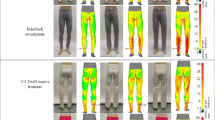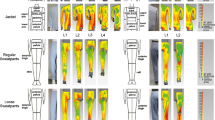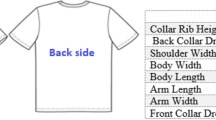Abstract
The purpose of this paper is to analyse the impact of design solutions on the thermal insulation of the garments and the ensembles. Previous studies investigated the microclimatic air gaps and volumes, however only under the first - and the second - layered clothing. Since none of the previous studies covered three - layered ensembles, in this study ensembles were accompanied by jackets of different fit and length to investigate the ensembles’ thermal insulation. Variants of bomber jacket differ in the amount of the ease allowance, while variants of the parka differ in length. The thermal insulation of the ensembles increased for 21.6 to 59.7 % when one of the jacket variants was added as the outerwear garment. A threshold volume, after which the thermal insulation will start to decrease due to convection, wasn’t determined for the outerwear third - layered garments nor was the impact of the length of the garment on the thermal insulation clearly stated. This study involved laboratory testing of garments and ensembles by 3D body scanning and thermal manikin measurements. To evaluate the volume of the microclimatic air volume the accurate 3D body scanning was used and the impact of the microclimatic volume on the ensemble’s insulation was tested. The thermal insulation for the selected outerwear garments and afterwards ensembles was measured by resting thermal manikin. Analysis of the results obtained from tests, showed that the garments’ fit and length can be used to model the overall thermal insulation of the ensembles. The ensembles insulation enlargement was measured for microclimatic volumes up to 33.57 dm3 (measured with ensembles accompanied with bomber jacket). The study proved that the limiting microclimatic volume is greater for three - layered clothing, than previously reported. The overall ensembles’ insulation increased simultaneously with the length enlargement (measured with ensembles accompanied with parka jacket). Findings will be of help in the future research on garments and ensembles thermal properties modelled through the design process and the construction.
Similar content being viewed by others
References
V. K. Kothari and M. Anbarasan, Indian J. Fibre Text. Res., 5, 49 (1990).
C. A. Wilson, R. M. Laing, and D. J. Carr, J. Hum. Environ. Syst., 5, 69 (2002).
“Advances in the Dyeing and Finishing of Technical Textiles, Woodhead Publishing Series in Textiles: No. 138”, 1st ed. (M. L. Gulrajani Ed.), pp.260-262, Woodhead Publising Ltd., Cambridge, 2013.
Y. Lee, K. Hong, and S.-A. Hong, Appl. Ergon, 38, 349 (2013).
Z. Zhang and J. Li, J. Fiber Bioeng Inform., 4, 137 (2011).
Z.-H. Zhang, Y. Wang, and J. Li, Fibres Text. East. Eur., 19, 105 (2011).
J. Kwon and J. Choi, J. Physiol. Anthropol., 32, 11 (2013).
E. A. McCullough, B. W. Jones, and J. Huck, “A Comprehensive Data Base for Estimating Clothing Insulation, Technical Report 84-01”, pp.29–47, Institute for Environmental Research, Kansas State University, Manhattan, 1984.
ISO 9920:2009 Ergonomics of the Thermal Environment-Estimation of Thermal Insulation and Water Vapour Resistance of a Clothing Ensemble.
G. Havenith, R. Heus, and W. A. Lotens, Ergonomics, 33, 67 (1990).
Y. Taya, S. Ohno, and K. Mihira, J. Home. Econ. Jpn., 33, 374 (1982).
R. P. Clark and M. L. de Calcina-Goff, J. R. Soc. Interface, 6, 767 (2009).
G. Havenith, “Proceedings of 11th International Conference on Environmental Ergonomics”, 2005.
E. Mert, A. Psikuta, and M.-A. Bueno Rossi, Int. J. Biometeorol., 59, 1701 (2015).
J. L. Spencer-Smith, Cloth. Res. J., 5, 3 (1977).
I. Holmér, H. Nilsson, G. Havenith, and K. C. Parsons, Ann. Occup. Hyg., 43, 329 (1999).
G. Havenith, I. Holmér, E. A. Den Hartog, and K. C. Parsons, Ann. Occup. Hyg., 43, 329 (1999).
J. Li, Z. Zhang, and Y. Wang, J. Text I., 104, 1327 (2013).
E. Mert, S. Böhnisch, A. Psikuta, and M.-A. Bueno, “Proceedings of the 6th International Conference on 3D Body Scanning Technologies”, 2015.
B. A. MacRea, R. M. Laing, and C. A. Wilson, Text. Res. J., 81, 1962 (2011).
H. Daanen, K. Hatcher, and G. Havenith, “Proceedings of the 10th International Conference on Environmental Ergonomics”, 2002.
A. Psikuta, J. Frackiewicz-Kaczmarek, I. Frydrych, and R. M. Rossi, Text. Res. J., 82, 1405 (2012).
Z. Zhang, J. Li, and Y. Wang, Indian J. Fibre Text. Res., 40, 392 (2015).
Z.-H. Zhang and J. Li, “TBIS 2010-Textile Bioengineering and Informatics Symposium Proceedings”, 2010.
F. Wang, J. Ergonom., 1, 103 (2011).
ISO 3636:1977 Size Designation of Clothes-Men’s and Boys’ Outerwear Garments.
ISO 8559-2:2017 Size Designation of Clothes-Part 2: Primary and Secondary Dimension Indicators.
BS EN 13402-3:2017 Size Designation of Clothes. Size Labelling Based on Body Measurements and Intervals.
ISO/TR 10652:1991 Standard Sizing Systems for Clothes.
B. Cain, “Thermal Resistance of Some Protective Clothing Ensembles”, Defence Research Establishment, Ottawa, 1991.
ISO 3801:1977 Textiles-Woven fabrics-Determination of Mass Per Unit Length and Mass Per Unit Area.
ISO 5084:1996 Textiles-Determination of thickness of Textiles and Textile Products.
ISO 9237:1995 Textiles-Determination of the Permeability of Fabrics to Air.
ISO 11092:2014 Textiles—Physiological Effects-Measurement of Thermal and Water-vapour Resistance under Steady-state Conditions (sweating guarded-hotplate test).
Z. K. Amirova and O. V. Sakulina, “Izgotovlenie spetsialnoi i sportivnoi odezhdy. Legprombytizdat”, Moskva, 1985.
M. J. Moll and V. Wright, Ann. Rheum. Dis., 31, 1 (1972).
F. Burgo, “Il Modellismo-Tecnica del modello sartoriale alta moda e industriale donna–uomo–bambino/a”, 1st ed., p.251, Istituto di moda Burgo, Milano, 2004.
P. J. Myers-McDevitt, “Complete Guide to Size Specification and Technical Design”, 1st ed., Fairchild Books, New York, 2004.
ISO 20685:2010 3D Scanning Methodologies for Internationally Compatible Anthropometric Databases.
ISO 15831:2004 Clothing-Physiological Effects-Measurement of Thermal Insulation by means of a Thermal Manikin.
“Protective Clothing: Managing Thermal Stress, Woodhead Publishing Series in Textiles: No. 154”, 1st ed. (F. Wang and C. Gao Eds.), pp.3-38, Woodhead Publising Ltd., Cambridge, 2014.
BS EN 14058:2004 Protective Clothing - Garment for Protection Against Cool Environments.
Author information
Authors and Affiliations
Corresponding author
Rights and permissions
About this article
Cite this article
Špelić, I., Rogale, D., Mihelić Bogdanić, A. et al. Changes in Ensembles’ Thermal Insulation According to Garment’s Fit and Length Based on Athletic Figure. Fibers Polym 19, 1278–1287 (2018). https://doi.org/10.1007/s12221-018-1074-8
Received:
Revised:
Accepted:
Published:
Issue Date:
DOI: https://doi.org/10.1007/s12221-018-1074-8




